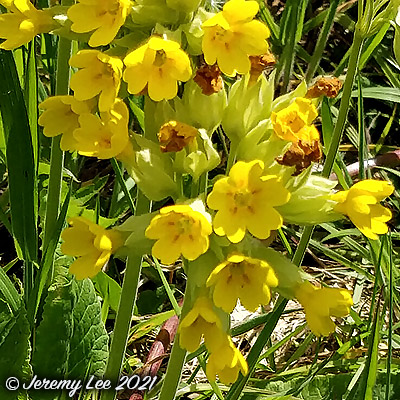
 |
|
Scientific Classifications explained » Amphibians » Ants » Aphids » Bees » Beetles » Birds » Bugs » Butterflies » Caterpillars » Damselflies » Dragonflies » Earwigs » Flies » Frog/Leafhoppers » Fungi » Galls » Grasshoppers » Harvestmen » Hoverflies » Lacewings » Ladybirds » Leaf Mines » Lichens » Mammals » Millipedes » Mosses » Moths » Sawflies » Slugs » Snails » Spiders » Trees & Shrubs » Wasps » Wild Flowers » Woodlice » Postboxes |
UK Nature > Wild Flowers > Yellow Wild Flowers > Primula veris

Scientific Name: Primula veris Common Name: Cowslip Primula veris, more commonly known as Cowslip, is an attractive flowering plant found in meadows and on woodland floors. The leaves are green and wrinkled, and quite wide but narrow towards the end. The leaf edges are toothed, and a light cream-green vein can clearly be seen in the centre of the leaf. They grow in a basal rosette formation. The flowers are bright yellow, bell-shaped, and have five petals with small indents on the top edge of each petal. The flowers are enclosed by a long, green, tube-shaped calyx (protective flower casing) and are found in clusters on each plant, all facing to one side. Cowslips are to be found right across the UK. Look for them in meadows, grassland, woodland and verges as well as in gardens. They thrive on dry, calcareous (chalky) soils and flower between April and May. Cowslips are important for wildlife as their flowers are an early source of nectar for various insects including bees, beetles and butterflies such as the brimstone. Cowslip is also a food plant for the Duke of Burgundy butterfly. |
|

https://www.uknature.co.uk is a website dedicated to showing the immense diversity of UK nature and wildlife. Our vast range of habitats, from lowland arable to snow covered mountains, from storm-ravaged coastlines to peaceful inland freshwater lakes and rivers, from dry, sandy heaths to deciduous and coniferous forests, all these habitats contribute to the abundance of UK nature. We have wild birds in huge numbers either residing or visiting our shores (597 recorded species as at July 2013) and we must also not forget the humble back garden with its grass lawns, flower beds filled with nectar rich flowers, shrubs and trees, all designed to attract huge numbers of insects such as bees, moths, butterflies and hoverflies; and finally the small ponds which provide safe havens for frogs, toads, newts and even slow worms and grass snakes. www.uknature.co.uk is the showcase for my personal passion, photographing uknature in all its glory. I sincerely hope you all enjoy the fruits of my labours. This site and all images contained therein is © Jeremy Lee 2004 - 2025. All Rights Reserved. Site design by Jeremy Lee. Site development & IT Support by Stuart Lee. |